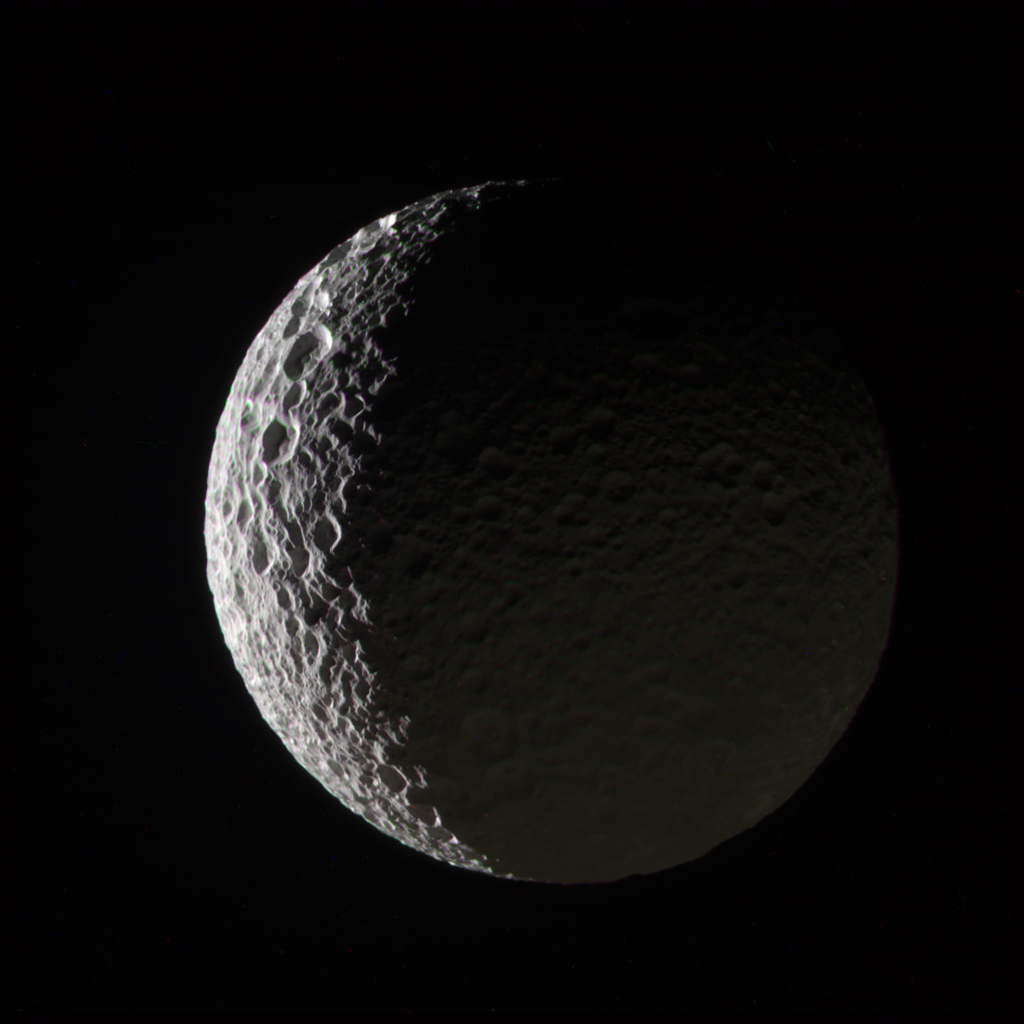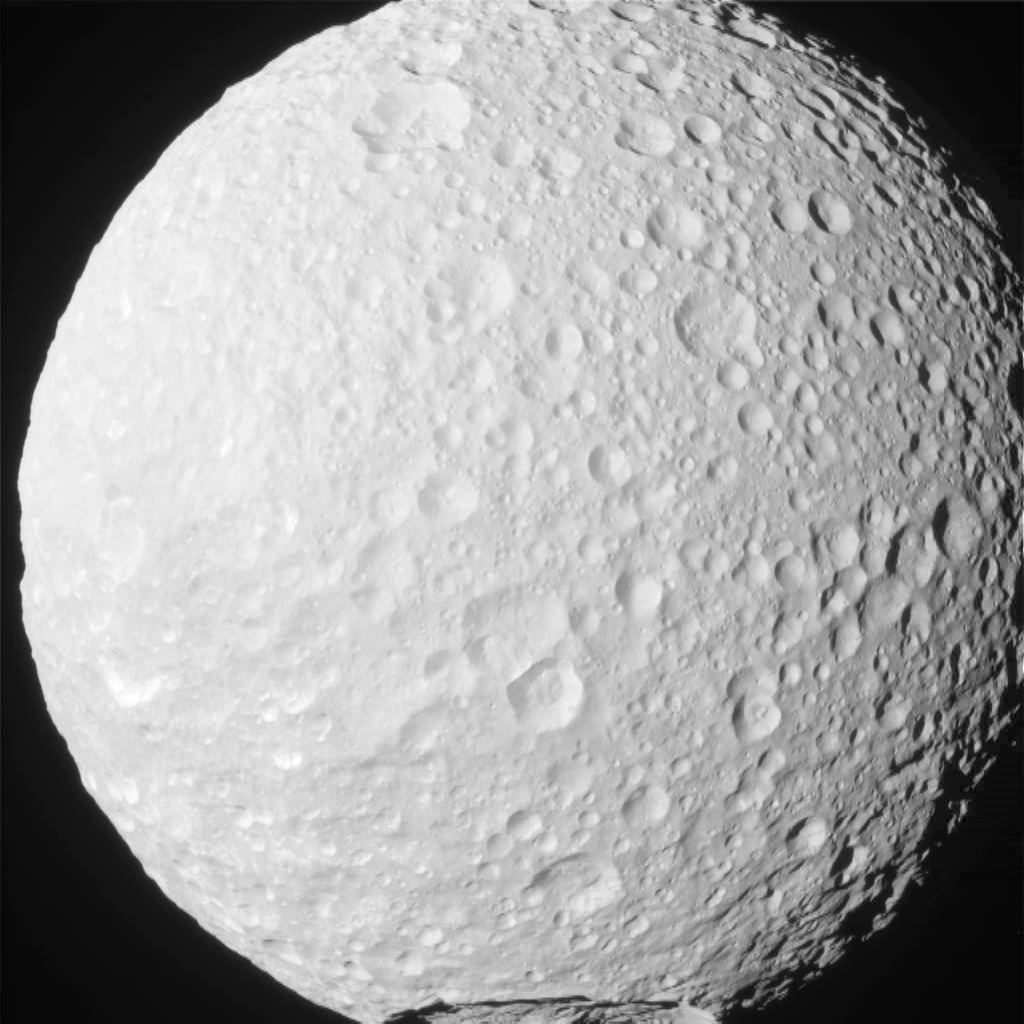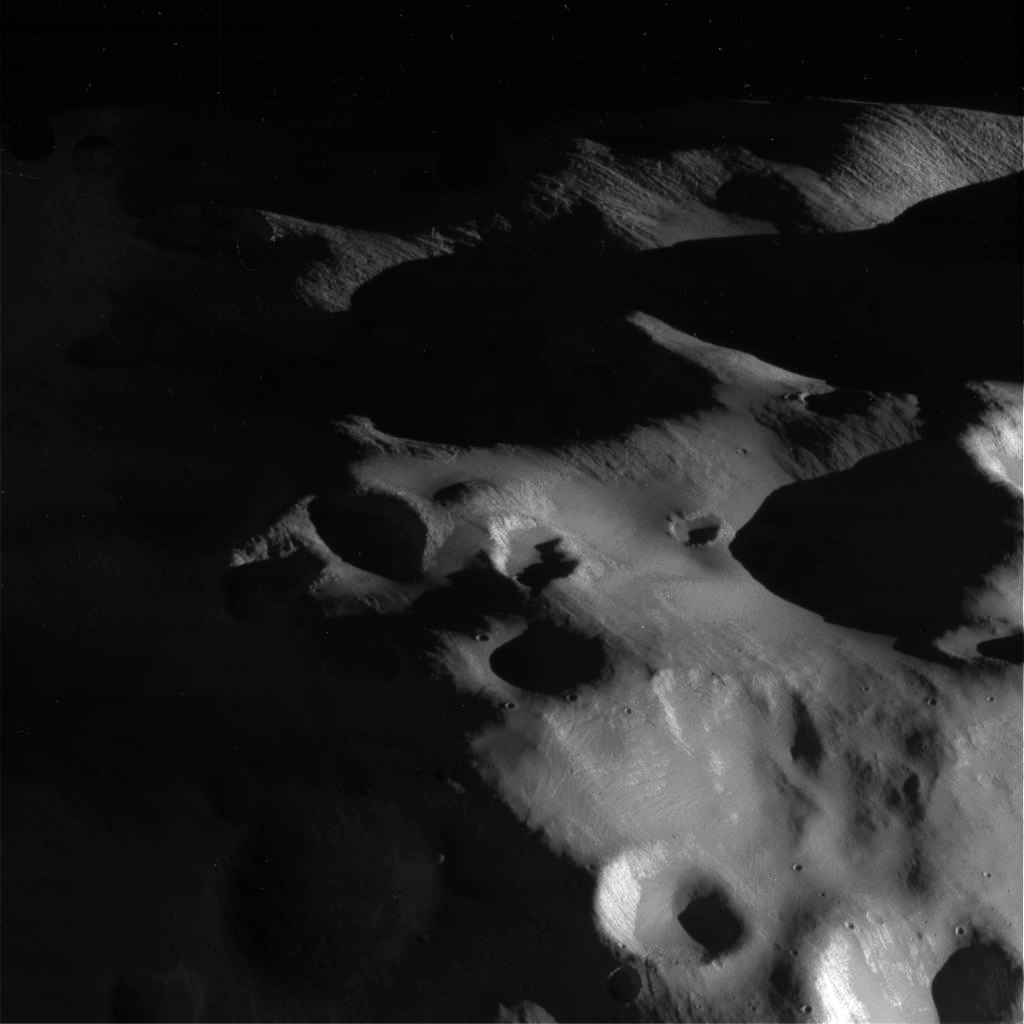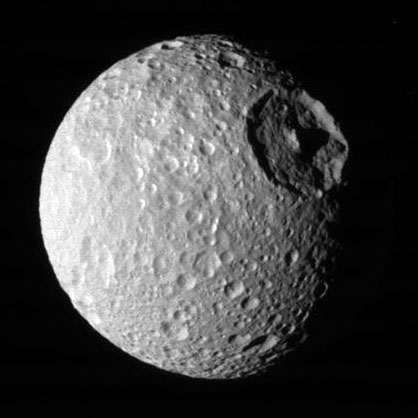It looks like you're using an Ad Blocker.
Please white-list or disable AboveTopSecret.com in your ad-blocking tool.
Thank you.
Some features of ATS will be disabled while you continue to use an ad-blocker.
share:
Mimas is a moon of Saturn which was discovered in 1789 by William Herschel
This quality of this picture is just incredible, remember to check out the original full size.
This raw, unprocessed image of Mimas was taken on January 30, 2017 and received on Earth February 1, 2017. The camera was pointing toward Mimas at approximately 42933 kilometers away, and the image was taken using the CL1 and GRN filters.

ciclops.org...
This quality of this picture is just incredible, remember to check out the original full size.
This raw, unprocessed image of Mimas was taken on January 30, 2017 and received on Earth February 1, 2017. The camera was pointing toward Mimas at approximately 42933 kilometers away, and the image was taken using the CL1 and GRN filters.
With a diameter of 396 kilometres (246 mi) it is the smallest astronomical body that is known to be rounded in shape because of self-gravitation.

ciclops.org...
a reply to: Spacespider
That is beautiful.
Just stunning. The contrasts between light and dark, the craters and the mounds between them... This is one of those images that on its own, excuses the human eye for all the ugliness it has ever seen, just on the merit of this one example of beauty.
That is beautiful.
Just stunning. The contrasts between light and dark, the craters and the mounds between them... This is one of those images that on its own, excuses the human eye for all the ugliness it has ever seen, just on the merit of this one example of beauty.
a reply to: Spacespider
Amazing thanks, I would like to add to that picture that because of its size it could quiet easily be a gall bladder stone released from Saturn.
Amazing thanks, I would like to add to that picture that because of its size it could quiet easily be a gall bladder stone released from Saturn.
a reply to: Spacespider
First thing i thought of was golf ball before they became cut proof . Awesome pic .
First thing i thought of was golf ball before they became cut proof . Awesome pic .
a reply to: Spacespider
From the pounding it has taken from an endless barrage of lesser bodies, it seems safe to suggest that it was forged into its ball shape by the non-stop, if indeed, slow, re-distribution of its surface materials.
From the pounding it has taken from an endless barrage of lesser bodies, it seems safe to suggest that it was forged into its ball shape by the non-stop, if indeed, slow, re-distribution of its surface materials.
a reply to: Spacespider
That is a cool picture , is it a Moon or a golf ball ?
Cassini just keeps on giving.
That is a cool picture , is it a Moon or a golf ball ?
Cassini just keeps on giving.
The method they use to get those photographs must still be classified.
Anyone know if the real name of the Groom Lake base is 61 characters long?
I searched for "Los Alamos "still me"" nothing came up?
When did the Poles decide that guys site was too sensitive?
Anyone know if the real name of the Groom Lake base is 61 characters long?
I searched for "Los Alamos "still me"" nothing came up?
When did the Poles decide that guys site was too sensitive?
edit on 4-3-2017 by Cauliflower because: (no reason given)
a reply to: Spacespider
I see what you did there.
Pretty soon, somebody's gonna have to admit that science got it wrong again. Fancy-pants words or completely ignoring the elephant in the room is such crap.
A solid round ball floating around in space ... hmmmmm ...
I see what you did there.
With a diameter of 396 kilometres (246 mi) it is the smallest astronomical body that is known to be rounded in shape because of self-gravitation.
Pretty soon, somebody's gonna have to admit that science got it wrong again. Fancy-pants words or completely ignoring the elephant in the room is such crap.
A solid round ball floating around in space ... hmmmmm ...
edit on 432017 by Snarl because: bold
a reply to: Spacespider
It looks like a giant fluffy candy apple made of marshmallow- great, now i'm hungry.
I only know Mimas by name but it looks like it's tidally locked and It looks like there are a few impact craters-Perhaps strays from Saturns rings? all I know is moons can provide more information on stellar gestation (That one's on the house Professor DeGrasse Tyson) and can shed light on the evolution of our solar system and other systems.
It looks like a giant fluffy candy apple made of marshmallow- great, now i'm hungry.
I only know Mimas by name but it looks like it's tidally locked and It looks like there are a few impact craters-Perhaps strays from Saturns rings? all I know is moons can provide more information on stellar gestation (That one's on the house Professor DeGrasse Tyson) and can shed light on the evolution of our solar system and other systems.
a reply to: Spacespider
that is really amazing, looks like that poor thing had the worst chicken pox scars
that is really amazing, looks like that poor thing had the worst chicken pox scars
This is very cool, and we're gonna get even cooler closeup images as Cassini spacecraft nears the end of its mission and swings closer and closer to
Saturn.
I've created this true-colour image of Mimas from raw Cassini images taken through red, green, and blue filters:

What's also cool is that the nightside half of Mimas is backlit by saturnshine (sunlight reflected off Saturn).
Cassini also took this great shot of the sunlit side of Mimas:

That's one heavily cratered moon!
~~~
Speaking of great Cassini closeups, here's one of Epimetheus (a very cool name for a moon!)

It's almost like Cassini was coming in for a landing!
The raw image here: saturnraw.jpl.nasa.gov...
I've created this true-colour image of Mimas from raw Cassini images taken through red, green, and blue filters:

What's also cool is that the nightside half of Mimas is backlit by saturnshine (sunlight reflected off Saturn).
Cassini also took this great shot of the sunlit side of Mimas:

That's one heavily cratered moon!
~~~
Speaking of great Cassini closeups, here's one of Epimetheus (a very cool name for a moon!)

It's almost like Cassini was coming in for a landing!
The raw image here: saturnraw.jpl.nasa.gov...
edit on 4-3-2017 by wildespace because: (no
reason given)
Thanks for posting the raw unprocessed image of Mimas; very interesting, it has really been hammered. Resolution at that distance is
excellent.
Mimas is composed mostly of ice water ice with a small amount of rock which accounts for the deep craters and high rims as compared to our own denser Moon.
edit on 4-3-2017 by lunarcartographer because: comment added.
Mimas is composed mostly of ice water ice with a small amount of rock which accounts for the deep craters and high rims as compared to our own denser Moon.
edit on 4-3-2017 by lunarcartographer because: Added comment,
To think some craters are over 250 miles in diameter and that the original collider was 12 to 25 miles across and vapourised instantly at the point of
collision.
originally posted by: stormcell
To think some craters are over 250 miles in diameter and that the original collider was 12 to 25 miles across and vapourised instantly at the point of collision.
The Original Post states that Mimas is only 246 miles in diameter.
It looks like a very lonely place.
How can there be such a wide variety of moons circling Saturn? Some are smooth, some are crater-lumpy...Titan almost looks like it has an atmosphere, with clouds.
The theory of the solar system's formation is that clumps of materials cooled to form the planets and their satellites. If true, shouldn't the "clump" that coalesced into the Saturn and it's moons, be made of the same material..thereby causing all the moons to look nearly the same?
originally posted by: carewemust
How can there be such a wide variety of moons circling Saturn? Some are smooth, some are crater-lumpy...Titan almost looks like it has an atmosphere, with clouds.
Titan does have an atmosphere, quite a big and thick one too. Relatively smooth moons (like Enceladus) are so because they are covered in ice which gets constantly renewed from the ocean below it. Each moon has its own geological processes, that's why they look so different.
The theory of the solar system's formation is that clumps of materials cooled to form the planets and their satellites. If true, shouldn't the "clump" that coalesced into the Saturn and it's moons, be made of the same material..thereby causing all the moons to look nearly the same?
The moons are pretty much made of the same material (mostly water ice with some rocks inside, and hydrocarbons on the surface). But Saturn, being so incredibly massive, managed to hold on to all that Hydrogen that was surrounding it when it formed.
new topics
-
Electrical tricks for saving money
Education and Media: 23 minutes ago -
VP's Secret Service agent brawls with other agents at Andrews
Mainstream News: 1 hours ago -
Sunak spinning the sickness figures
Other Current Events: 2 hours ago -
Nearly 70% Of Americans Want Talks To End War In Ukraine
Political Issues: 2 hours ago -
Late Night with the Devil - a really good unusual modern horror film.
Movies: 4 hours ago -
Cats Used as Live Bait to Train Ferocious Pitbulls in Illegal NYC Dogfighting
Social Issues and Civil Unrest: 5 hours ago -
The Good News According to Jesus - Episode 1
Religion, Faith, And Theology: 7 hours ago -
HORRIBLE !! Russian Soldier Drinking Own Urine To Survive In Battle
World War Three: 9 hours ago
top topics
-
SETI chief says US has no evidence for alien technology. 'And we never have'
Aliens and UFOs: 16 hours ago, 8 flags -
Cats Used as Live Bait to Train Ferocious Pitbulls in Illegal NYC Dogfighting
Social Issues and Civil Unrest: 5 hours ago, 8 flags -
Florida man's trip overseas ends in shock over $143,000 T-Mobile phone bill
Social Issues and Civil Unrest: 12 hours ago, 8 flags -
VP's Secret Service agent brawls with other agents at Andrews
Mainstream News: 1 hours ago, 6 flags -
Former Labour minister Frank Field dies aged 81
People: 14 hours ago, 4 flags -
Bobiverse
Fantasy & Science Fiction: 12 hours ago, 3 flags -
HORRIBLE !! Russian Soldier Drinking Own Urine To Survive In Battle
World War Three: 9 hours ago, 3 flags -
Nearly 70% Of Americans Want Talks To End War In Ukraine
Political Issues: 2 hours ago, 3 flags -
Sunak spinning the sickness figures
Other Current Events: 2 hours ago, 3 flags -
Late Night with the Devil - a really good unusual modern horror film.
Movies: 4 hours ago, 2 flags
active topics
-
WF Killer Patents & Secret Science Vol. 1 | Free Energy & Anti-Gravity Cover-Ups
General Conspiracies • 32 • : Arbitrageur -
Is there a hole at the North Pole?
ATS Skunk Works • 38 • : Therealbeverage -
Cats Used as Live Bait to Train Ferocious Pitbulls in Illegal NYC Dogfighting
Social Issues and Civil Unrest • 11 • : charlyv -
SETI chief says US has no evidence for alien technology. 'And we never have'
Aliens and UFOs • 41 • : TheMisguidedAngel -
Naked Eye Supernova Erupting in the T Coronae Borealis
Space Exploration • 13 • : Therealbeverage -
The Real Reason Behind the Sean Combes Exposure
Political Conspiracies • 45 • : ThatSmellsStrange -
VP's Secret Service agent brawls with other agents at Andrews
Mainstream News • 14 • : lilzazz -
Electrical tricks for saving money
Education and Media • 0 • : annonentity -
Late Night with the Devil - a really good unusual modern horror film.
Movies • 4 • : DBCowboy -
Hate makes for strange bedfellows
US Political Madness • 41 • : Solvedit

